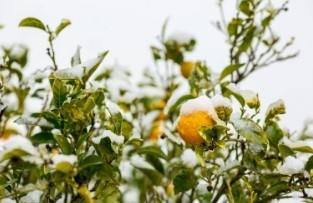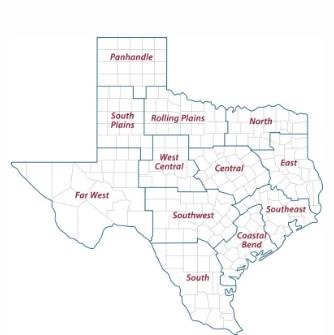Texas citrus growers took a beating during Winter Storm Uri in February, but according to a Texas A&M AgriLife Extension Service expert, there are signs of life in South Texas.

Orange tree branches covered by snow. Surviving citrus trees have bounced back from extreme freeze in February, but growers took a hard hit. (Stock photo)
Juan Anciso, Ph.D., AgriLife Extension horticulturist, Weslaco, said Texas citrus trees are bouncing back, but fruit is sparce this season following the storm.
An AgriLife Extension study estimated the severe freeze caused $230 million in damage to Texas’ citrus industry. Around 80% of the orange crop and almost 70% of the grapefruit crop maturing in 2020 was harvested by the time the storm arrived, but citrus tree damages were extensive and caused a massive loss of 2021 blooms and subsequent fruit potential.
Texas citrus battered, but recovering
Many individual growers were dealt severe losses, including total orchard losses, Anciso said. Young, 1-2 years old, and older trees were especially susceptible to the cold.
Producers have been rehabilitating mature survivor trees, those 5-20 years old, since the freeze by cutting back and removing all dead woody material. Trees were typically pruned by hand and/or topped and hedged by machine.
Removing dead wood reduces the risk of melanose infestations, which can cause severe damage for commercial citrus crops, Anciso said. Melanose is a fungal disease that can spread throughout the tree from young or dead twigs, and that is especially common following freezes and fueled by any subsequent humid conditions.
“Trees that made it are looking good and showing very good canopy,” he said. “But I am surprised there is any fruit this year given the timing of the severe freeze. Citrus trees bloom from February through early March, and I expected zero production because trees are so vulnerable at that time. But there is some fruit out there.”
Texas citrus fruit makes a showing

Piles of citrus trees sit in the aftermath of Winter Storm Uri. (Texas A&M AgriLife photo by Juan Anciso)
Anciso said one of the region’s three large packing plants reported it was in the middle of harvest and shipping quality citrus to retail grocers. But another of the operations shut down in the wake of Winter Storm Uri.
There are also salvageable grapefruit and oranges being sold by roadside peddlers in the region, but Anciso said he does not know what percentage of marketable citrus is being shipped to other parts of the state compared to a typical year.
Poor fruit sets caused other management issues as well, Anciso said. Producers were not inclined to treat trees for pests like rust mites due to a lack of fruiting potential, and infestations were rampant.
Many orchards were bulldozed, he said. Some producers were able to salvage young tree root stock and regraft fruit production varieties to them, but piles of dead trees on once active orchards are evidence of the storm’s damage.
“Trees that were too young or too old did not fare well,” he said. “If producers had older trees that were in decline before the storm or very young trees, they were likely bulldozed, and it’s still up in the air as to whether those acres will return to production in many cases.”
Citrus orchards look to bounce back
Most crops and orchards were insured, and there is hope that Texas citrus will return to pre-storm levels, but it remains uncertain.
Anciso said producers were hesitant to make major investments into their orchards following the freeze even after they saw new growth on trees. Input costs, including fertilizer, fuel and pesticide and fungicides, were all up significantly, and availability was limited in some cases. Young citrus trees were also in short supply, which was a problem for growers hoping to reestablish their orchards and have fruit in three to five years.
“I think production next year will be back to normal as far as per-acre production because most trees that made it are looking really good,” he said. “But it will be a while before we know how it all shakes out for the industry here.”
AgriLife Extension district reporters compiled the following summaries:

A map of the 12 Texas A&M AgriLife Extension districts.
CENTRAL
Conditions were drier and cooler, including a couple near-frost nights. Winter wheat plantings resumed under excellent soil moisture conditions. Wheat acres were expected to be similar to last year. Warmer conditions were in the forecast along with potentially heavy rainfall by Thanksgiving Day. Most wheat acres were expected to be planted before the rains arrive. Pasture grasses were going dormant now due to the cooler soil conditions. Livestock were in good condition and grazing crop stubble. Stock tank levels were in good condition.
ROLLING PLAINS
The first freeze was reported in some areas. Winter wheat continued to struggle with lack of moisture. Producers were replanting poorly germinated areas but slow to apply fertilizers due to increased cost and no rainfall. Some areas reported sufficient moisture for wheat and good growing conditions. Winter ryegrass was coming along, but overseeded fields were producing slower. There has been limited stocker cattle movement to wheat pastures, so supplemental feeding of hay was prevalent. Cattle looked excellent, and calves were being weaned and shipped. Cotton harvest was complete in some areas and getting underway in other areas with almost all fields defoliated.
COASTAL BEND
Very little rainfall was reported, and soil moisture levels were declining in some areas. All crops were harvested with the exception of a very small amount of cotton in Wharton County due to water standing in fields. Some fieldwork was being done to control weeds and plow rows. Some producers were fertilizing. Seed orders for next year were being placed. Late-season hay harvest continued. Pecan harvest continued. Livestock were doing well. Many producers weaned calves and were culling cows. There were large runs of cattle at local auctions.
EAST
Some rain was reported, but not enough to impact soil moisture levels. Subsoil and topsoil conditions were adequate to short. High winds and cooler temperatures slowed grass growth. Pasture and rangeland conditions were fair. Livestock were in fair to good condition with supplemental feeding taking place. Some producers were putting out hay. Fertilizer prices continued to climb. Feral hog control was underway in much of the district.
SOUTH PLAINS
Subsoil and topsoil moisture levels were still low due to lack of moisture. Most producers finished peanut harvest and were working on sorghum, corn, sunflowers and cotton. Producers continued stripping cotton, and most operations should be finished by Thanksgiving. Winter wheat planting continued across the district, but rainfall was needed to get fields going. Cattle were in good condition.
PANHANDLE
Producers were beginning to wrap up harvests. Corn harvest was completed, and grain sorghum harvest was getting close. Winter wheat plantings were continuing with producers irrigating on earlier plantings to be able to get some grazing. Cotton harvest continued with yields looking favorable. Producers continued to work fields with compost and manure application ongoing. Dry conditions continued to impact forage production in rangelands and wheat fields.
NORTH
Soil moisture ranged from adequate to very short. Daytime temperatures dropped into the mid-50s. Oat field conditions were very poor to good. Winter wheat was emerging and in poor to good condition. Pastures and rangelands were mostly in fair to good condition. Some counties reported very poor pasture and rangeland conditions. Livestock were in good condition, but cattle needed grain and hay.
FAR WEST
No precipitation was reported. Conditions were cooler and drier with the first freezing temperatures reported in higher elevations. Daytime highs were in the mid- to upper-70s and overnight lows averaged in the upper 30s to lower 40s. Grazing conditions were not improving, and the cold weather caused some plants to go dormant. Grasses in area pastures were curing and rangeland conditions were declining. Around 75% of Pima and upland cotton was harvested. Some farmers were expected to harvest cotton after a good freeze. For the most part, alfalfa producers were done for the season, although some smaller operations were pushing for a last clipping. Corn harvest was in full swing. Winter wheat needed moisture. Pecan producers were waiting for a couple of good freezes to begin harvest. Ranchers were still shipping out cattle and continue to feed livestock and wildlife.
WEST CENTRAL
Conditions were mild and dry. Windy conditions did not help moisture levels. Wheat looked good but needed rain. Pecan harvest continued, but yields were extremely light for most producers. Cotton farmers ramped up harvest activity with the good weather. Livestock remained in mostly good condition.
SOUTHEAST
Soil moisture was drying out, and ryegrass was taking off in pastures. Some areas reported short soil moisture, but most areas reported adequate levels. Some farmers were still trying to cut hay ahead of a cold front in the forecast. Rye, wheat and oats planted for forage had all emerged. Wheat in bottomlands looked good. Second-growth and ratoon rice were harvested. Livestock were in fair condition with some reports of sick animals due to temperature swings and damp conditions. Cotton harvest continued and was close to wrapping up.
SOUTHWEST
Cooler temperatures and windy conditions were reported. Rangelands and pasture were in fair to good condition, and soil moisture levels continued to dry. Oat and wheat fields were still being planted. Small grains planted earlier in the season were doing well. Livestock were in fair to good condition, and producers were providing supplemental feed. Deer hunters were reporting that harvested deer were in great shape.
SOUTH
Northern areas reported very short to short soil moisture levels, while western and southern parts reported very short to adequate conditions. Eastern areas reported short to surplus soil moisture levels. Some scattered showers fell with several areas reporting 1-2 inches up to 5 inches of rainfall in one area. Pasture and rangeland conditions continued to decline in drier areas and improve in areas that received rainfall, but summer grasses were going dormant. Livestock were being fed supplementally. Cattle and the calf crop looked good, and prices were up some. Above-average numbers of cattle were being marketed at area sale barns. Stock tanks were low in some areas, and producers were stocking up on hay. There was little row crop activity as most fields were prepared for next year. Peanut harvest was underway. Spinach and other greens were planted. Fall vegetables were being planted, and strawberry planting was complete. Vegetable crops looked good, and some producers were harvesting fall crops. Oat food plots were germinating. Whitetail deer harvests were slow due to abundant food supplies. There was some concern about the amount of potential wildfire fuel in pastures. Citrus trees were close to harvest, and many trees were still recovering.
Source : tamu.edu